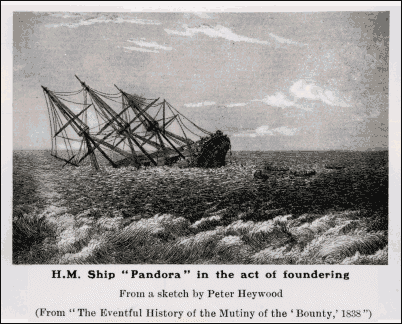A Voyage Round the World in His Majesty's Frigate
Pandora, by George Hamilton 
By permission of National Library of Australia
|
Those who confine their interest in the Bounty saga to the
mutiny on the ship and Bligh's perilous small boat voyage across the
western Pacific afterward are missing an equally gripping "rest of
the story." This is the voyage, shipwreck and aftermath of HMS
Pandora, the ship sent to capture and bring the Bounty
mutineers to justice. The story of the voyage has been most completely told in a book
published in 1793 by George Hamilton, Pandora's surgeon. The
book enjoyed only a limited circulation. Now comes the first
faithful reproduction of Hamilton's account in a limited printing.
Many similarities between the voyages of the Bounty and the
Pandora will be found in this new, rare volume. Australian National Maritime Museum in conjunction with Hordern
House, publishers and dealers in rare books and manuscripts, have
joined in publishing Dr. Hamilton's 1793 account in a 205-page
edition that contains an exact facsimile of the 165-page original
edition. It is handsomely bound in quarter cherry Scottish calf with
marbled paper sides. While available, the book may be obtained from
Hordern House, 77
Victoria Street, Potts Point, Sydney NSW 200l, Australia. Titled A Voyage Round the World in His Majesty's Frigate
Pandora, it is the fourth book in the Australian
Maritime Series that makes available facsimile printings of
important rare books which are either unobtainable today or which
would sell for tens of thousands of dollars. The book includes a forward by British High Commissioner Alex
Allan, and a most instructive summary of the Pandora's place
in the Bounty saga by Peter Gesner of the Queensland Museum,
who is considered the leading expert on the Pandora's voyage.
The surgeon's account reveals that, like Bounty,
Pandora was an overly crowded ship as she sailed from
England. "...like Weevils, we had to eat a hole in our bread, before
we had a place to lay down in," writes Hamilton. Both Bounty and Pandora encountered serious trouble
shortly after sailing: Bounty was storm-struck; 35 of
Pandora's crew came down with a lingering malignant fever, the
surgeon's only assistant being one of the first to become ill. Living quarters on Bounty were rearranged to accommodate
breadfruit plants that were to be taken to the West Indies. The same
arrangement was made on Pandora and for the same purpose.
"Our officers here ... showed the most manly and philanthropic
disposition, by giving up their cabins ... in accommodating boxes
with plants of the Bread-fruit tree, that the laudable intentions of
government might not be frustrated from the loss of his majesty's
ship Bounty," Dr. Hamilton writes. The similarities continue with uncanny regularity, particularly
after Pandora is wrecked and her survivors make their
trouble-plagued way in small boats to the same Dutch East-India
settlements that the Bligh-led Bounty survivors reached. As would be expected, Hamilton pays careful attention to medical
matters about the voyage. But his interest also runs to such trivia
as the taste of native puddings, and the fact that on the back of a
picture of Captain Cook owned by Tahitian King Ottoo it was
customary for visiting navigators to record the arrival and
departure of their ships. The surgeon also intimates that he himself was not above
succumbing to the feminine charms (and the resulting venereal
disease) that surrounded him while at Tahiti. Some time after
leaving the island, he records, "We now began to discover, that the
ladies of Otaheite had left us with many warm tokens of their
affection." A faithful recorder of the many islands, reefs, shoals, sounds,
capes, bays and mountains discovered after leaving Tahiti,
Hamilton's precise observation that "A sandy key, four miles off,
and about thirty paces long" from the sinking Pandora, gave
present-day marine archaeologists the clues needed to find the
deeply submerged wreckage of the ship. This volume is filled with previously hidden information about
Pandora's voyage and her place in the Bounty saga. Those wise
enough to add it to their libraries will find themselves returning
to it time and again to discover or rediscover the myriad facts
Pandora's surgeon has told in a refreshingly light and
humorous way about the ship, the crew, the island people, and the
voyage to reach safety after the ship's destruction. [Pandora Encyclopedia] [HMS Pandora] | 




